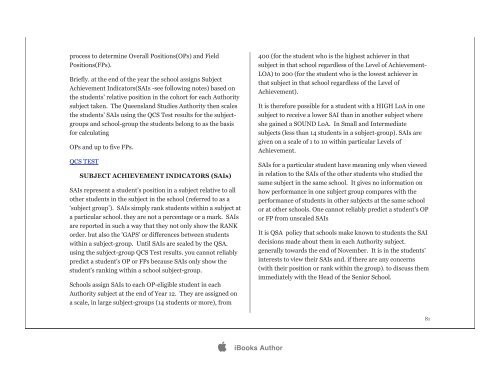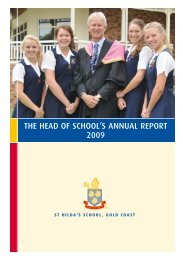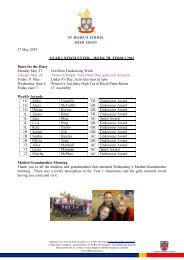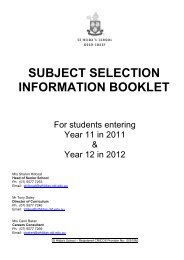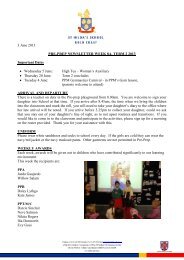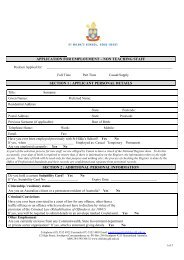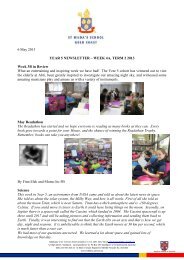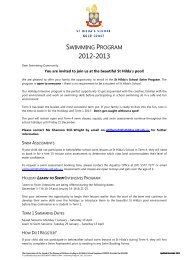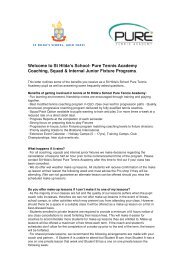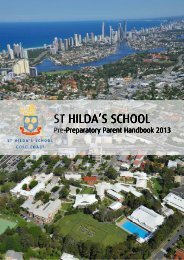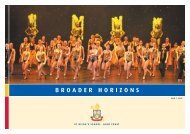Subject Selection iBook - St Hildas School
Subject Selection iBook - St Hildas School
Subject Selection iBook - St Hildas School
You also want an ePaper? Increase the reach of your titles
YUMPU automatically turns print PDFs into web optimized ePapers that Google loves.
process to determine Overall Positions(OPs) and Field<br />
Positions(FPs).<br />
Briefly. at the end of the year the school assigns <strong>Subject</strong><br />
Achievement Indicators(SAIs -see following notes) based on<br />
the students' relative position in the cohort for each Authority<br />
subject taken. The Queensland <strong>St</strong>udies Authority then scales<br />
the students' SAIs using the QCS Test results for the subjectgroups<br />
and school-group the students belong to as the basis<br />
for calculating<br />
OPs and up to five FPs.<br />
QCS TEST<br />
SUBJECT ACHIEVEMENT INDICATORS (SAIs)<br />
SAIs represent a student’s position in a subject relative to all<br />
other students in the subject in the school (referred to as a<br />
‘subject group’). SAIs simply rank students within a subject at<br />
a particular school. they are not a percentage or a mark. SAIs<br />
are reported in such a way that they not only show the RANK<br />
order. but also the 'GAPS' or differences between students<br />
within a subject-group. Until SAIs are scaled by the QSA.<br />
using the subject-group QCS Test results. you cannot reliably<br />
predict a student's OP or FPs because SAIs only show the<br />
student's ranking within a school subject-group.<br />
<strong>School</strong>s assign SAIs to each OP-eligible student in each<br />
Authority subject at the end of Year 12. They are assigned on<br />
a scale, in large subject-groups (14 students or more), from<br />
400 (for the student who is the highest achiever in that<br />
subject in that school regardless of the Level of Achievement-<br />
LOA) to 200 (for the student who is the lowest achiever in<br />
that subject in that school regardless of the Level of<br />
Achievement).<br />
It is therefore possible for a student with a HIGH LoA in one<br />
subject to receive a lower SAI than in another subject where<br />
she gained a SOUND LoA. In Small and Intermediate<br />
subjects (less than 14 students in a subject-group). SAIs are<br />
given on a scale of 1 to 10 within particular Levels of<br />
Achievement.<br />
SAIs for a particular student have meaning only when viewed<br />
in relation to the SAIs of the other students who studied the<br />
same subject in the same school. It gives no information on<br />
how performance in one subject group compares with the<br />
performance of students in other subjects at the same school<br />
or at other schools. One cannot reliably predict a student's OP<br />
or FP from unscaled SAIs<br />
It is QSA policy that schools make known to students the SAI<br />
decisions made about them in each Authority subject.<br />
generally towards the end of November. It is in the students'<br />
interests to view their SAIs and. if there are any concerns<br />
(with their position or rank within the group). to discuss them<br />
immediately with the Head of the Senior <strong>School</strong>.<br />
81<br />
apple <strong>iBook</strong>s Author


